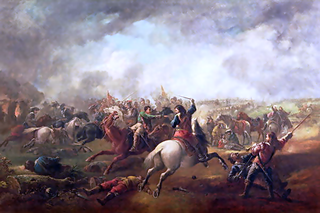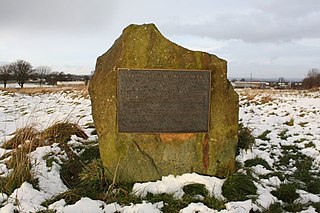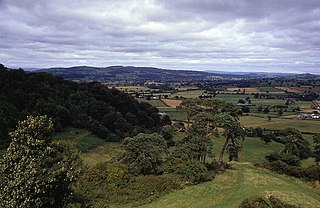
The Battle of Marston Moor was fought on 2 July 1644, during the First English Civil War of 1642–1646. The combined forces of the English Parliamentarians under Lord Fairfax and the Earl of Manchester and the Scottish Covenanters under the Earl of Leven defeated the Royalists commanded by Prince Rupert of the Rhine and the Marquess of Newcastle.

The Battle of Naseby was a decisive engagement of the First English Civil War, fought on 14 June 1645 between the main Royalist army of King Charles I and the Parliamentarian New Model Army, commanded by Sir Thomas Fairfax and Oliver Cromwell. It was fought near the village of Naseby in Northamptonshire.

The Battle of Edgehill was a pitched battle of the First English Civil War. It was fought near Edge Hill and Kineton in southern Warwickshire on Sunday, 23 October 1642.

The Battle of Nantwich was fought on 25 January 1644 in Cheshire during the First English Civil War. In the battle, Sir Thomas Fairfax in command of a Parliamentarian relief force defeated Lord Byron and the Royalists.

Marmaduke Langdale, 1st Baron Langdale was a leading Yorkshire Royalist during the Wars of the Three Kingdoms; although he was a talented commander of cavalry, his troops had a reputation for poor discipline.

The Battle of Winceby took place on 11 October 1643 during the First English Civil War near the village of Winceby, Lincolnshire. In the battle, a Royalist relieving force under the command of Sir William Widdrington was defeated by the Parliamentarian cavalry of the Earl of Manchester.

The Battle of Adwalton Moor occurred on 30 June 1643 at Adwalton, West Yorkshire, during the First English Civil War. In the battle, the Royalists loyal to King Charles led by the Earl of Newcastle soundly defeated the Parliamentarians commanded by Lord Fairfax.

The first Siege of Hull marked a major escalation in the conflict between King Charles I and Parliament during the build-up to the First English Civil War. Charles sought to secure the large arsenal held in Kingston upon Hull, East Riding of Yorkshire. He first approached the town in late April 1642, but was rebuffed by the town's Parliamentarian governor, Sir John Hotham. Charles retreated to York, but in July he received news that Hotham might be willing to hand over the town if the Royalists approached with a large enough force that Hotham could surrender with his honour intact.

The Battle of Powick Bridge was a skirmish fought on 23 September 1642 just south of Worcester, England, during the First English Civil War. It was the first engagement between elements of the principal field armies of the Royalists and Parliamentarians. Sir John Byron was escorting a Royalist convoy of valuables from Oxford to King Charles's army in Shrewsbury and, worried about the proximity of the Parliamentarians, took refuge in Worcester on 16 September to await reinforcements. The Royalists despatched a force commanded by Prince Rupert. Meanwhile, the Parliamentarians sent a detachment, under Colonel John Brown, to try to capture the convoy. Each force consisted of around 1,000 mounted troops, a mix of cavalry and dragoons.
The Eastern Association of counties was a Parliamentarian organisation during the English Civil War. It provided and administered an army which eventually became a mainstay of the Parliamentarian military effort towards the end of 1644.

The Battle of Sourton Down was a successful Parliamentarian ambush at Sourton Down, in South West England, on 25 April 1643, during the First English Civil War. After a failed attack on Royalist-held Launceston, the Parliamentarians fell back on their base at Okehampton, pursued by a Royalist army under Sir Ralph Hopton, who marched overnight, planning to attack the town at dawn.

The Battle of Seacroft Moor took place in Whinmoor moor near the village of Seacroft, north-east of Leeds in West Riding on 30 March 1643 during the First English Civil War. In the battle, a Parliamentarian force commanded by Lieutenant-General Thomas Fairfax was decisively beaten by a Royalist cavalry force commanded by George Goring.

The unsuccessful second Siege of Hull by the Royalist Earl of Newcastle in 1643 was a victory for Parliament at the high point of the Royalist campaign in the First English Civil War. It led to the abandonment of the Earl of Newcastle's campaign in Lincolnshire and the re-establishment of Parliament's presence in Yorkshire.
The First English Civil War started in 1642. By the end of the year neither side had succeeded in gaining an advantage, although the King's advance on London was the closest Royalist forces came to threatening the city.
Sir John Hotham the younger, known as Captain Hotham, was an English Member of Parliament and military commander who fought for the Parliamentarians during the First English Civil War. He was executed for treason in 1645.

The Battle of Selby occurred on 11 April 1644 in North Yorkshire during the First English Civil War. In the battle, the Parliamentarians led by Lord Fairfax attacked and captured the strategic Royalist garrison of Selby under the command of John Belasyse.

The Battle of Montgomery took place during the First English Civil War of 1642–1646. On 17 September 1644, a Parliamentarian force commanded by Sir John Meldrum advanced to engage a Royalist army led by Lord Byron which was besieging Montgomery Castle in mid Wales. The battle was fought the next day. After the Royalists gained an initial advantage, the Parliamentarians counter-attacked and destroyed Byron's army.
The Battle of Leeds took place during the First English Civil War on 23 January 1643, when a Parliamentarian force attacked the Royalist garrison of Leeds, Yorkshire. The attack was partly dictated by the need to maintain local support for the Parliamentarian cause; the Earl of Newcastle had recently shifted the balance of power in Yorkshire in the Royalists' favour with the addition of his 8,000-strong army, and sent one of his commanders, Sir William Savile to capture Leeds. The West Riding of Yorkshire relied on the cloth trade, and Ferdinando, Lord Fairfax sent his son, Sir Thomas Fairfax to bolster the defences of nearby Bradford, before agreeing to his request to attack Leeds.

The Capture of Wakefield occurred during the First English Civil War when a Parliamentarian force attacked the Royalist garrison of Wakefield, Yorkshire. The Parliamentarians were outnumbered, having around 1,500 men under the command of Sir Thomas Fairfax, compared to the 3,000 led by George Goring in Wakefield, but successfully stormed the town, taking roughly 1,400 prisoners.

The Battle of Tadcaster took place during the First English Civil War on 7 December 1642, when a Royalist force attacked the Parliamentarian garrison of Tadcaster, Yorkshire, which was held by between 900 and 1,500 soldiers under the command of Ferdinando Fairfax, Lord Fairfax. Newcastle marched out of York on 6 December, and split his force of 6,000 into two; he took 4,000 infantry down the main York–Tadcaster road to attack the town from the east, while sending a deputy, the Earl of Newport, with a further 1,500 to circle around and trap the Parliamentarians by attacking from the north-west.


















